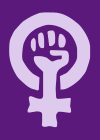Radical lesbianism
Two movements of radical lesbians are known. One was the U.S.-based movement of the mid to late 1960s. The other was the Front des lesbiennes Radicales, or FLR, which began in France in 1980 and became organized in 1981 under the name Front des lesbiennes Radicales.[1] An offshoot of the latter movement developed shortly after, in the French-speaking province of Quebec, Canada.[2]
U.S.-based 1960s movement
Radical lesbian organizations in the mid to late 1960s in the U.S. were small, well known, and outspoken; among "charismatic" leaders, according to Deborah Siegel, were Rita Mae Brown.[3][4] Radicalesbians was a group in New York.[4] Although feminist and lesbian movements have been closely linked, there actually exists some hostility between radical lesbian and feminist groups.[5]
French-based 1980s movement
Similarities and differences between lesbian separatism and radical lesbianism
The principles of radical lesbianism are similar to those of English-language lesbian separatism, however, there are some important basic differences.[6][7] In her preface to Monique Wittig's The Straight Mind, Quebec radical lesbian Louise Turcotte explains her views that "Radical lesbians have reached a basic consensus that views heterosexuality as a political regime which must be overthrown."[6] Turcotte notes that Lesbian Separatists "create a new category" (i.e., separation from men and heterosexual culture)"[6] and that the radical lesbian movement aims for the "destruction of the existing framework of heterosexuality as a political regime".[6] Turcotte goes on to discuss Adrienne Rich's landmark essay, Compulsory Heterosexuality and Lesbian Existence, noting that Rich describes heterosexuality as a violent political institution that has to be "imposed, managed, organized, propagandized and maintained by force".[8] Rich sees lesbian existence as an act of resistance to this institution, but also as an individual choice, whereas the principles of radical lesbianism see lesbianism as necessary, and consider its existence as necessarily outside of the Heterosexual political sphere of influence.[6]
Influence of Monique Wittig
The Front des lesbiennes Radicales, were inspired by the words and writings of French philosopher Monique Wittig,[6] and their philosophic inquiries began through a Paris-based group including Wittig and Simone de Beauvoir who published the journal Questions féministes.[9] Wittig's 1981 essay, One is not Born a Woman, titled after Simone de Beauvoir's observation, posits that "Lesbians are not women," as "what makes a woman is a specific social relation to a man, a relation that we have previously called servitude, a relation which implies personal and physical obligation as well as economic obligation, ... a relation which lesbians escape by refusing to become or to stay heterosexual".[10] Wittig also believed that "lesbianism provides ...the only social form in which (lesbians) can live freely".[10]
In the encyclopedia Who's Who in Lesbian and Gay Writing, editor Gabriele Griffin calls Wittig's writing "part of a larger debate about how heteropatriarchy and women's oppression within it might be resisted".[10]
Development of radical lesbian culture in Quebec
The 1980s and 1990s saw the development of a number of Francophone lesbian periodicals in Quebec, Canada, including Amazones D'hier: Lesbiennes D'aujourd'hui, Treize, and L'evidante lesbienne.[2] This was also a period of strength for French-language lesbian presses such as Editions nbj and Oblique Editrices, and lesbian bookstores like Montreal's L'Essentielle.[2]
See also
References
- ↑ Martel, Frederic. The Pink and the Black: Homosexuals in France Since 1968, Stanford University Press, 2000, ISBN 0-8047-3274-4, p119
- 1 2 3 Gammon, Carolyn. Lesbian Studies in Francophone Institutions and Organizations, in Gay and Lesbian Studies Henry L. Minton, Ed., Haworth Press, 1992, ISBN 1-56023-021-5, p155
- ↑ Riley, G. (2001). Inventing the American Woman: Since 1877. Inventing the American Woman: An Inclusive History. Harlan Davidson. p. 533. ISBN 978-0-88295-958-0. Retrieved 31 August 2018.
- 1 2 Siegel, Deborah, Sisterhood, Interrupted: From Radical Women to Grrls Gone Wild (N.Y.: Palgrave Macmillan, 2007 ( ISBN 978-1-4039-8204-9)), p. 38 (author PhD & fellow, Woodhull Institute for Ethical Leadership).
- ↑ Murray, Heather (2007). "Free for All Lesbians: Lesbian Cultural Production and Consumption in the United States during the 1970s". Journal of the History of Sexuality. 16 (2): 251–275.
- 1 2 3 4 5 6 Turcotte, Louise. (foreword) The Straight Mind and Other Essays, Monique Wittig, Beacon Press, 1992, ISBN 0-8070-7917-0, p ix-x
- ↑ Kramarae & Spender. Routledge International Encyclopedia of Women: Global Women's Issues, Routledge, 2000, ISBN 0-415-92089-2, p785
- ↑ Rich, Adrienne. Compulsory Heterosexuality and Lesbian Existence, Signs 5, no.4, Summer 1980
- ↑ Duchen, Claire. Feminism in France: From May '68 to Mitterrand, Routledge, 1986, ISBN 0-7102-0455-8, p24
- 1 2 3 Wittig, Monique (1992). The Straight Mind and Other Essays. Beacon Press. p. 32. ISBN 978-0-8070-7917-1. OCLC 748998545.
